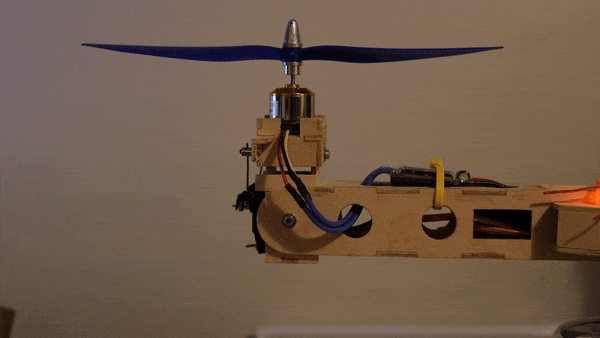Introduction: Tricopter With Front Tilting Motor.
So this is a little experiment, which will hopefully lead onto a hybrid tricopter/gyrocopter?
So there is nothing really new about this tricopter, its basically the same as my normal tricopter as shown in this instructable. However it has been lengthened using a new center hub. And the front yaw controlling arm can be interchanged for a new arm which not only has the yaw control on it but can also tilt the motor forward. You may ask "WHY?" well to answer that i need to explain how the model flies forward and what limits the forward speed.

Supplies
Please see my Tricopter instructable for the materials but also add the following.
- 2 * servos i used Corona DS-319MG from HobbyKing, these are smaller servos, but high speed and metal geared.
Model: DS-319MG
Operating Voltage: 4.8V / 6.0V
Operating Speed: 0.07sec.60º/ 0.06sec.60º
Stall Torque: 3.2kg.cm / 4kg.cmv Size: 32.5 x 17 x 34.5mm
Weight: 34g (inc wire and plug) - Piano wire for the servo links and some means of connecting the wire to the arm.
Step 1: Why?
So let's look at how a normal drone flies forward. It doesn't matter if its a tricopter or quad or another multicopter, they all basically adjust the power of the motors to promote the model to become unbalanced and lean, this then causes the model to fly in that direction. With the KK 2.1.5 flight control board which i use for most of my experimental models you can adjust the performance and hence the amount the model will lean, however at some point the model will be tilting to much that the power lifting the model won't be enough to overcome the weight. I have tried this with one of my quads, with a good run up i could basically apply full forward (Elevator stick fully forward) and full throttle, the angle would get to about 45 degrees and man would it disappear into the distance! (but wouldn't go up)
So this is where the tilting front motor comes in. I can make my tricopter go forward without having to lean the whole model, all i have to do is tilt the front motor and the drone will want to fly forwards. This should in theory give me loads more forward speed? and i hope with the addition of wings allow the rear motors to slow down and the wings create the lift. Maybe the rear propellers will act like the rotor on a gyrocopter?
the two pictures attempt to show the difference, My Son was attempting to follow the drone with a camera which isn't easy! the first picture shows the tricopter without the tilt and you can see the whole model is tilted. In the second picture the front motor is tilted and the model flys level.
You may have guessed this is an experiment!
Step 2: Central Hub
There are two main differences from my normal tricopter. the first is the central hub. As you can see in the pictures a normal tricopter would have the 3 motors spaced at 120 degrees apart meaning they are equally spaced around the hub. However on this model i wanted to sweep back the year two arms and make the model longer. So the new hub puts and angle of 60 degrees between the two rear motors, and i designed the hub to give me about 10mm separation between the two 10" propellers. However the two rear arms are still the same design as before.
This is the first time i have reinforced the hub, normally i rely on the arms to keep the top and bottom parts of the hub in place. But in this case the length proved to be too much and the ply was able to flex far too much. So to overcome this problem i added sides to the hub which made for a nice sturdy hub.
Step 3: The Tilting Motor
So the biggest difference by far is the tilting front motor. This required the old arm to be totally redesigned and due to the added weight of the extra servo I choose to use a pair of smaller servos. Also due to the fact that one servo (YAW) is now at the very end of the arm I choose to mount the other (TILT) servo nearer to the hub.
This Arm looks quite complicated, not only does it have the motor power and ESC receiver lead, but it now has two more servo leads.
As with all of my drones the arms are designed to be interchangeable so for the initial testing I used a normal yaw arm with no tilt. This allowed me to see how the model would handle with the swept back arms. Due to the Corna Lock down I was forced to try the model out in my garden, however it turns out that it performs very well and is a pleasure to fly.
I then swapped over the YAW arm for the new tilt version. I set the tilt angle on the gear switch and only allowed about 15 degrees movement. When I tried it out it nearly ended very quickly. The newly positioned YAW servo now operates the opposite way around so I quickly found out that the model spins out of control! Thankfully i only lifted the model a few inches of the ground so no harm was done. With the YAW servo channel reversed I gave it another go. Flicking the switch initially has very little response. The model gradually moves away, but then it speeds up! So at this point I had to stop until I could escape the lockdown as my garden isn't that big!
When we were finally allowed out i had a good test of the model and managed to get some video. I found the model to still fly well but it always had that requirement to fly forward which is what i was expecting. You could pull back on the elevator and make the model stay still but this obviously made the model not sit horizontal!
Step 4: KK2.1.5 Program
Due to the fact that the arms are not at 120 Degrees apart the settings in the KK2.1.5 board had to be changed in the mixing table.
It's worth pointing out that the tilting servo has nothing to do with the Flight controller. It is just connected to the receiver directly and switched using the gear switch on my transmitter. I would have preferred a adjustable pot but that isn't an option on my radio.
| Channel 1 | Channel 2 | Channel 3 | Channel 4 | |
|---|---|---|---|---|
| Throttle | 100 | 100 | 100 | 0 |
| Aileron | 0 | 50 | -50 | 0 |
| Elevator | 100 | -87 | -87 | 0 |
| Rudder | 0 | 0 | 0 | 100 |
| Offset | 0 | 0 | 0 | 50 |
| Type | ESC | ESC | ESC | Servo |
| Rate | High | High | High | Low |
You can see the motor layout in one of the pictures. However it's not quite correct and doesn't show the servo. I have gone into a lot of detail on the yaw servo in my Quintcopter instructable. But basically none of the motors have any bearing on the yaw, the yaw is solely controlled by the servo and the KK2.1.5 flight controller doesn't need to know (or care) on which arm it sits. Also the picture shows all the propellers going in the same direction. This is ok, but i prefer to have 2 going one direction and the other the opposite, i believe this lessens the angle on the yaw arm?
One last thing to add in this section is the wiring, I found out whilst testing this model that number one ESC got very hot. If you think about it the number one ESC supplies the flight controller, which has a servo connected to it for the YAW and it also supplies the receiver which in turn is also driving a servo (TILT) So the number one ESC BEC was driving the fight controller two fast metal geared servos and the receiver! SO you may be able to see in the picture that i removed the YAW servo positive wire from the flight controller and connected it to the ESC number 3 BEC.
Step 5: Conclusion.
So this experimental project is looking quite good! and there is loads more to try. But as a last test today i tried to see how much tilt i could put on the front motor and still maintain a hover? If you think about it the more tilt you have the more the model wants to fly forward and the more you have to pull it back with the elevator. I was wondering if at some stage the flight controller would get upset but it was fine, however i ran out of elevator travel then couldn't stop it flying away. I think reviewing the video that you can hear that one of the propellers is really screaming, i am guessing that this must be the front one?
Next stage is to add wings and carry out tests to see what difference it makes on battery life?

Runner Up in the
Make It Fly Speed Challenge














